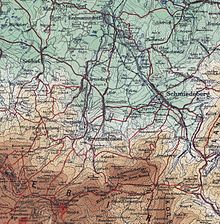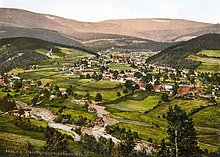Karpacz
| Karpacz | ||
|---|---|---|

|
|
|
| Basic data | ||
| State : | Poland | |
| Voivodeship : | Lower Silesia | |
| Powiat : | Jelenia Gora | |
| Area : | 37.96 km² | |
| Geographic location : | 50 ° 47 ' N , 15 ° 45' E | |
| Height : | 480 m npm | |
| Residents : | 4593 (Jun. 30, 2019) |
|
| Postal code : | 58-540 to 58-550 | |
| Telephone code : | (+48) 75 | |
| License plate : | DJE | |
| Economy and Transport | ||
| Next international airport : | Wroclaw | |
| Gmina | ||
| Gminatype: | Borough | |
| Residents: | 4593 (Jun. 30, 2019) |
|
| Community number ( GUS ): | 0206011 | |
| Administration (as of 2013) | ||
| Mayor : | Radosław Jęcek | |
| Address: | ul. Konstytucji 3 Maja 54 58-540 Karpacz |
|
| Website : | www.karpacz.pl | |
Karpacz [ ˈkarpaʧ ] ( German Krummhübel ) is a town in the powiat Jeleniogórski of the Polish Voivodeship of Lower Silesia . The city belongs to the Euroregion Neisse .
Geographical location
The village is located in Lower Silesia in the Giant Mountains at the little Lomnica at an altitude of 480- 885 m npm The center is located at 630 m npm height. Immediately south of the village, on the border with the Czech Republic , rises the Schneekoppe ( 1603 m nm ), the highest mountain in the Giant Mountains.
To the north and west of the village are the foothills of the Giant Mountains, which reach heights of 700 to 900 m .
history


Krummhübel was first mentioned in 1599 as a lead and iron mine for mining .
Around 1745 the village had a Protestant primary school that was housed in rented rooms; In 1772 a wooden schoolhouse was built. Around 1840 the villagers were dependent on the Protestant and Catholic churches in Arnsdorf to the north . The responsible patrimonial court was also in Arnsdorf. On site there was an old, disused mine, a water mill , a paper mill (a vat ), two brickworks, several looms for the production of cotton fabrics and linen , a fulling mill and a number of handicraft shops.
Before the end of the 19th century, Krummhübel was the headquarters of professional collectors of medicinal herbs who belonged to the closed guild of laboratory technicians or country pharmacists. They trained apprentices who, after five years of apprenticeship, acquired the right to prepare medicines according to medical specifications. But they also sold the remedies in markets and abroad. Around 1840 the guild had 18 members in Krummhübel and 27 in the mountains. The guild was formed by two Prague medical students who had fled here around 1700 to avoid a duel .
After the connection to the railway network of the Riesengebirgsbahn GmbH line, which was opened on June 6, 1895 and electrified in 1934 , various metal-processing industries were set up. In addition, the importance of tourism increased, which naturally came to a standstill during the First and Second World Wars . From 1910 to 1915 the Lomnitztalsperre was built near Krummhübel.
The German writer Else Ury had owned a vacation home in Krummhübel since the 1920s ; In 1939 it was expropriated because she was Jewish.
In 1945 Krummhübel belonged to the district of Hirschberg in the Giant Mountains in the administrative district of Liegnitz in the Prussian province of Silesia of the German Empire .
Towards the end of the Second World War, the region around Krummhübel was occupied by the Red Army in the spring of 1945 . In the summer of 1945, Krummhübel and almost all of Silesia were placed under Polish administration by the Soviet occupying power in accordance with the Potsdam Agreement . The Poles introduced the place name Karpacz for Krummhübel . The German residents, with the exception of individual families, were expelled from Krummhübel by the local Polish administrative authority by 1947 .
Since the place name Krummhübel had no equivalent in the Polish language, the place had three names in a short phase: Krzywa Góra (free translation of the term Krummhübel), Drogosławice (with the aim of sounding Polish, but could only be seen at the train station) and finally Karpacz , as many new residents from the Tatras or the Beskids , i.e. the Carpathians , had moved here. Between 1945 and 1989 the former district of Brückenberg was named "Bierutowice" (today Karpacz Górny ) after the first communist head of state, Bolesław Bierut . In 1960 the village received city rights. Since the opening of the borders after 1989, the city has grown in importance as an international tourist center.
- Population development
| year | Residents | Remarks |
|---|---|---|
| 1840 | 604 | mostly Protestant, in 102 houses |
| 1900 | 837 | |
| 1933 | 2298 | |
| 1939 | 2205 | |
| 2015 | 4888 |
Buildings
Churches
- Wang Church , a stave church from Norway in the Brückenberg district (1945–1989 Bierutowice , since 1990 Karpacz Górny ). All parts of it are made of wood, only the tower is brick. It was built in Norway in the 13th century and, on the initiative of Countess Friederike von Reden , dismantled into individual parts, transported to Krummhübel and rebuilt there.
- Herz-Jesu-Kirche (consecrated 1908) and Marienkirche (1910)
- Chapel of St. Laurentius on the Snow , first mentioned in the 17th century and renovated in the 19th century
Profane buildings (selection)
- Town hall in the city center, a church-like structure with a classicist base building and a high copper - roofed neo - baroque tower
- former hunting lodge, now used as a school
- listed houses in the city center, early 20th century
- Bread shop in the city center, Theodor Fontane's hostel during several summer vacations
coat of arms
The coat of arms is a three-part shield. The name of the place appears in silver capital letters in the black frame . In the upper field, the colors white, blue and red symbolize the mountain landscape, over which a golden sun spreads its rays. The lower left field contains three stylized brown spruces bordered with gold on a green background. The lower right field with three stylized fish on a blue background refers to the fish farming that used to be carried out here.
The current coat of arms was introduced by the Polish city administration in 2005.
Since the coloring does not quite meet the heraldic requirements, other coats of arms are also used: In the upper wide field the mountain appears in blue and silver, above which the sun rises, on the lower left there are three golden spruces on a green background and next to them three silver fish on a blue Reason arranged.
Town twinning
Karpacz has twinned cities with
- Gdynia in Poland,
- Kamenz in Germany (Saxony)
- Reichenbach / OL in Germany (Saxony) and
- Mutton , Favrskov municipality in Denmark.
There is also a friendship between cities with Oberwiesenthal in Germany (Saxony).
tourism
Its location makes the city next Szklarska Poreba ( Schreiberhau ) the most important center of the Polish Tourism in the Giant Mountains. The city is a starting point for hikes in the Giant Mountains, which is a national park on a large scale, offers opportunities for winter sports (→ ski Kopa , Biały Jar ski area ) and has approximately 8,500 guest beds. As a special attraction, toboggan runs (traditional and a weather-independent Alpine Coaster) are available to tourists. In 1923, 1929 and 1934 the German Luge Championships were held in Krummhübel, and in 1938 in the Brückenberg district.
In Karpacz there is the Orlinek, a K85 ski jumping hill, on which the jumping competitions of the 2001 Junior World Championships were held.
Tricks in legends, in literature, and an alleged gravitational anomaly
According to legend, the giant and mountain spirit Rübezahl lived here.
In the literature, Krummhübel was taken into account, among other things, by the story Die Laboranten von Krummhübel by Hans Reitzig. The so-called laboratory assistants, lay pharmacists, who used the wealth of herbs in the area to produce medicines, marketed them as far as Poland and Russia. The last laboratory assistant, Ernst August Zölfel, died in 1894. This subject was also taken up by Theodor Fontane , who spent numerous summers in Krummhübel and was inspired by an unsolved murder of a Krummhübel forester for his novel Quitt . Next to a road bridge over the Great Lomnica ( Łomnica ), a stone indicates an alleged gravitational disturbance, but this is actually an optical illusion: cars, bottles and balls seem to roll uphill on the road. However, the road actually has a downward gradient on this section. The confusion of the surrounding area leads to this illusion.
Venue of a conference of Nazi officials in April 1944
On April 3 and 4, 1944 , a "working conference of the Jewish officers " of twelve European diplomatic missions of the Foreign Office took place in Krummhübel, an alternative quarter of the Foreign Office due to the war . The meeting was initiated by Ribbentrop's information center for anti-Jewish foreign action and specifically proposed by Ribbentrops' liaison to Himmler , Horst Wagner . At this conference the participants agreed on intensifying anti-Jewish propaganda in Europe. Franz Alfred Six called for the “physical elimination of the Eastern Jews”, as the Foreign Affairs Officer Eberhard von Thadden recorded. Rudolf Schleier chaired the meetings. Other well-known participants in the campaign were Harald Leithe-Jasper , Adolf Mahr , Gustav Richter , Heinz Ballensiefen , Peter Klassen , Embassy Paris, Hans-Otto Meissner , Rome, Hans Hagemeyer and Ernst Kutscher . Specific details about the Shoah that were communicated during the session should expressly not be included in the minutes. The conference was intended to serve as the start of an “anti-Jewish foreign action” (or “anti-Jewish action point”).
Personalities
- Else Ury (1877–1943), German writer and children's book author and victim of the Nazi regime; owned a holiday home in Krummhübel.
literature
- Eckart Conze , Norbert Frei , Peter Hayes and Moshe Zimmermann : The Office and the Past . German diplomats in the Third Reich and in the Federal Republic , Karl Blessing Verlag, Munich 2010, ISBN 978-3-89667-430-2 . Further edition at the Federal Agency for Civic Education (BpB), series of publications
- Manfred Steinkühler: "Anti-Jewish foreign campaign". The conference of the advisors to Jews in April 1944 . In: Karsten Linne & Thomas Wohlleben (eds.): Patient history. For Karl Heinz Roth . 2001-Verlag , Frankfurt 1993, ISBN 3-86150-015-9 , p. 256-279 .
- Sebastian Weitkamp: Brown diplomats. Horst Wagner and Eberhard von Thadden as functionaries of the "Final Solution". Dietz, Bonn 2008, ISBN 3801241785
Web links
- Homepage of Karpacz German
- Karpacz 360 - virtual city
- Karpacz (Krummhübel)
- Article about Karpacz and Rübezahl
Individual evidence
- ↑ a b population. Size and Structure by Territorial Division. As of June 30, 2019. Główny Urząd Statystyczny (GUS) (PDF files; 0.99 MiB), accessed December 24, 2019 .
- ↑ a b c d e Johann G. Knie: Alphabetical-statistical-topographical overview of the villages, towns, cities and other places of the royal family. Preusz. Province of Silesia . 2nd edition, Breslau 1845, p. 327.
- ↑ a b Meyer's Large Conversation Lexicon . 6th edition, Volume 11, Leipzig / Vienna 1907, p. 749.
- ↑ Alicja Hirsch-Tabis / Ewa Katarzyna Tabis, Karpacz - Krummhübel . Dzieje miasta pod Śnieżką, Jelenia Góra 2005
- ^ A b Michael Rademacher: German administrative history from the unification of the empire in 1871 to the reunification in 1990. hirschberg.html # ew39hbrgkrumm. (Online material for the dissertation, Osnabrück 2006).
- ↑ Views of the town hall in Karpacz
- ↑ Udo Wörffel: Theodor Fontane in the Riesengebirge , Husum 2009, ISBN 978-3-373-00509-4
- ↑ Thomas Senkel and Timo Junker: Natural gravitational anomalies in Karpacz Gorny, Poland - Butzbach, Hessen - observations and measurement results with precision GPS , Institute for Gravitational Research, GÖDE Foundation, Waldaschaff, 2003.
-
↑ Sebastian Weitkamp: Brown diplomats. Horst Wagner and Eberhard von Thadden as functionaries of the “Final Solution” . JHW Dietz. Bonn 2008, ISBN 978-3-8012-4178-0 , p. 275 f.
Eckart Conze, Norbert Frei, Peter Hayes and Moshe Zimmermann: The Office and the Past. German diplomats in the Third Reich and in the Federal Republic , Munich 2010, pp. 196–199. - ↑ a b See the minutes of the conference of advisors on Jews in Krummhübel on April 3–4. April 1944, PA AA Zagreb Secret Files 27.2 Summary: Diplomats of the Final Solution on the website . The exact protocol: [1]
- ↑ Both names are preserved in the archives. Since this permanent institution did not come about, no name was clarified, so that both names are justified.
- ↑ The document. Appendix pp. 266–279 is essentially identical to the version under The exact protocol ... in notes. Attached in print is the exact sequence of the conference, i.e. a schedule, as well as a list of all participants including handwritten changes in this list. The beginning of the online version, a letter from the veil dated March 4, 1944, is missing in the print, referring to two previous telegrams regarding the preparation and importance of the conference to all diplomatic missions
- ↑ Review: Krummhübel 65 years ago with photos of the conference location; after the review in the SZ: Murderous Diplomats No. 251, from October 28, 2008







